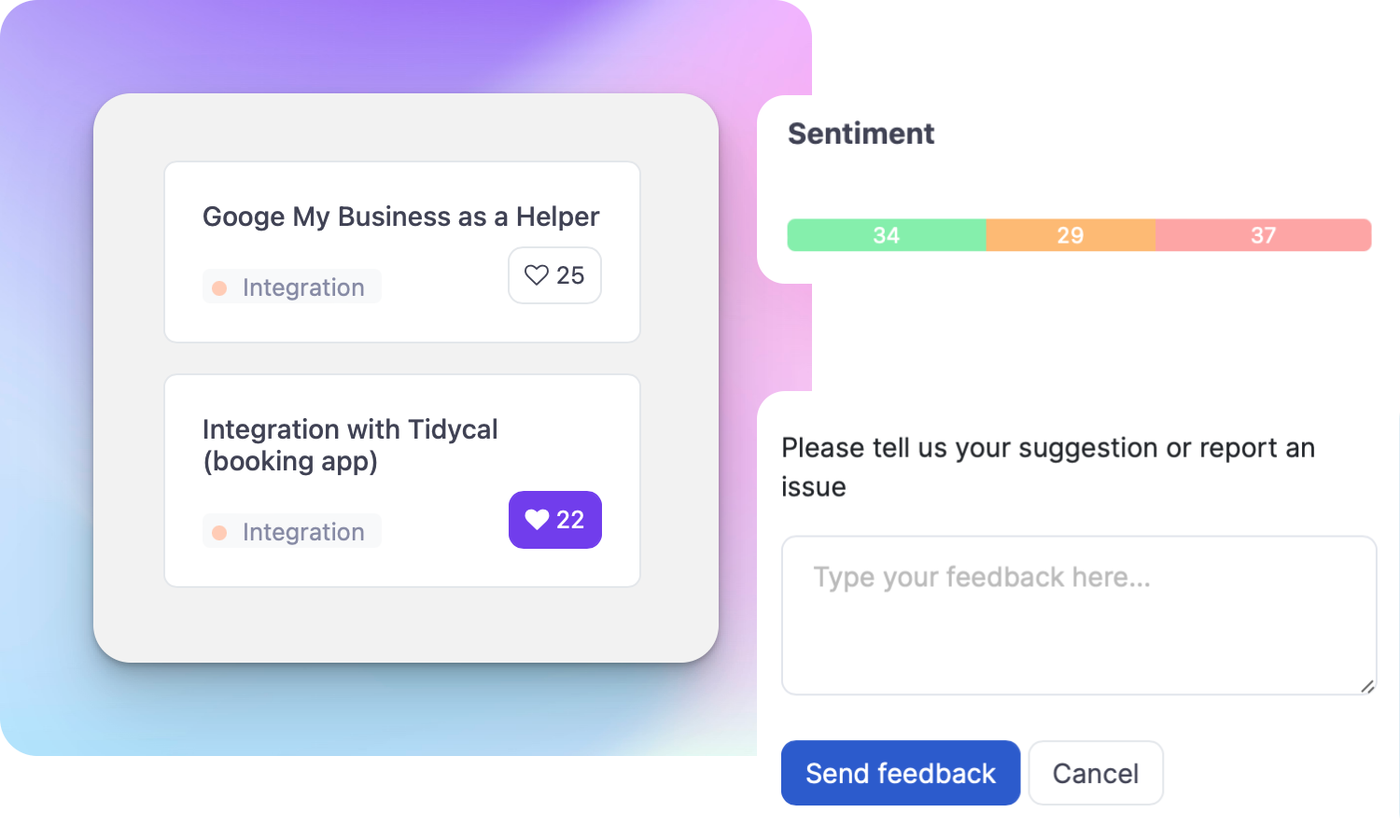Top 14 Aha! Alternatives

Ruben Buijs
17 minutes · Written on Mar 11, 2024

Aha! is a popular choice for product managers, providing a seamless way to co-create and engage with users.
However, no tool is perfect for everyone.
In this article, we will explore some alternative options to Aha!, highlighting their unique features and benefits.
Table of contents
- What is Aha!?
- Wait, why would people look for alternatives?
- Evaluation criteria
- Comparison tables
- Overview of the 14 best Aha! alternatives
- The best alternative for Aha!
- FAQ
What is Aha!?

Crowdsource feedback, engage your community, and analyze trends — so you can prioritize the best ideas
Wait, why would people look for alternatives
We'll explore why some users might be seeking alternatives to Aha! first.
- Limited Features and Customization:
Aha! is good, but if you need more features and customization, consider alternatives for a better fit. - Scalability and Pricing:
If Aha!'s plans don't match your growth, find a more flexible, cost-effective feedback tool. - Integration Possibilities:
Need to mesh your feedback tool with other apps? Look beyond Aha! for broader integration options. - User Interface and Experience:
An intuitive interface matters for user experience. If Aha! doesn't cut it for you, switch to a tool that's easier to use. - Unique Industry-Specific Needs:
For your unique industry needs, seek Aha! alternatives with features and integrations tailored to your sector.
Evaluation criteria
In order to adequately evaluate Aha! alternatives, I looked at a variety of factors:
- Functionality: Does the tool give product managers everything they need, with enough customization and data for good decisions?
- Reviews: What's the buzz among product managers about the tool? Do they like it and what could be better?
- Pricing: Are there pricing plans for all budgets without sacrificing key features? Is the cost worth it for what you get?
Now, let’s dive into Aha!’s top competitors!
Comparison tables
I love tables better than text myself, so let's start with a couple comparisons:
Features comparison
| Feature | Aha! | ProductLift | Nolt | Frill | ProductFlare | Pendo | Feedbear | Canny | Sleekplan | Headway | Noora | FeatureUpvote | Hellonext | Rapidr | UserVoice |
|---|---|---|---|---|---|---|---|---|---|---|---|---|---|---|---|
| Contribute Without Logging In | |||||||||||||||
| Private Boards | |||||||||||||||
| Weekly Reports | |||||||||||||||
| User Profiles | |||||||||||||||
| Internal Comments | |||||||||||||||
| Prioritization Matrix | |||||||||||||||
| Embeddable Widget | |||||||||||||||
| API Access | |||||||||||||||
| Single Sign-On (SSO) | |||||||||||||||
| Custom Statuses | |||||||||||||||
| Intercom Integration | |||||||||||||||
| Estimated Dates |
Languages comparison
| Language | Aha! | ProductLift | Nolt | Frill | ProductFlare | Pendo | Feedbear | Canny | Sleekplan | Headway | Noora | FeatureUpvote | Hellonext | Rapidr | UserVoice |
|---|---|---|---|---|---|---|---|---|---|---|---|---|---|---|---|
|
|
|||||||||||||||
|
|
|||||||||||||||
|
|
|||||||||||||||
|
|
|||||||||||||||
|
|
|||||||||||||||
|
|
|||||||||||||||
|
|
|||||||||||||||
|
|
|||||||||||||||
|
|
|||||||||||||||
|
|
|||||||||||||||
|
|
|||||||||||||||
|
|
|||||||||||||||
|
|
|||||||||||||||
|
|
|||||||||||||||
|
|
Reviews and awards comparison
| Product | G2 | Capterra | Trustpilot |
|---|---|---|---|
| Aha! | 4.3/5 | 4.7/5 | N/A |
| ProductLift | 5.0/5 | 4.9/5 | 4.4/5 |
| Nolt | 5.0/5 | 4.9/5 | N/A |
| Frill | 4.8/5 | 4.7/5 | 4.6/5 |
| ProductFlare | N/A | 4.5/5 | N/A |
| Pendo | 4.4/5 | 4.5/5 | 3.2/5 |
| Feedbear | 5.0/5 | 4.8/5 | 4.4/5 |
| Canny | 4.6/5 | 4.7/5 | 3.1/5 |
| Sleekplan | 4.8/5 | 5.0/5 | 4/5 |
| Headway | 3.0/5 | 5.0/5 | N/A |
| Noora | N/A | 4.8/5 | N/A |
| FeatureUpvote | N/A | N/A | N/A |
| Hellonext | 5.0/5 | N/A | N/A |
| Rapidr | 4.5/5 | N/A | N/A |
| UserVoice | 4.5/5 | 4.2/5 | 2.8/5 |
Overview of the 14 best Aha! alternatives
#1 ProductLift
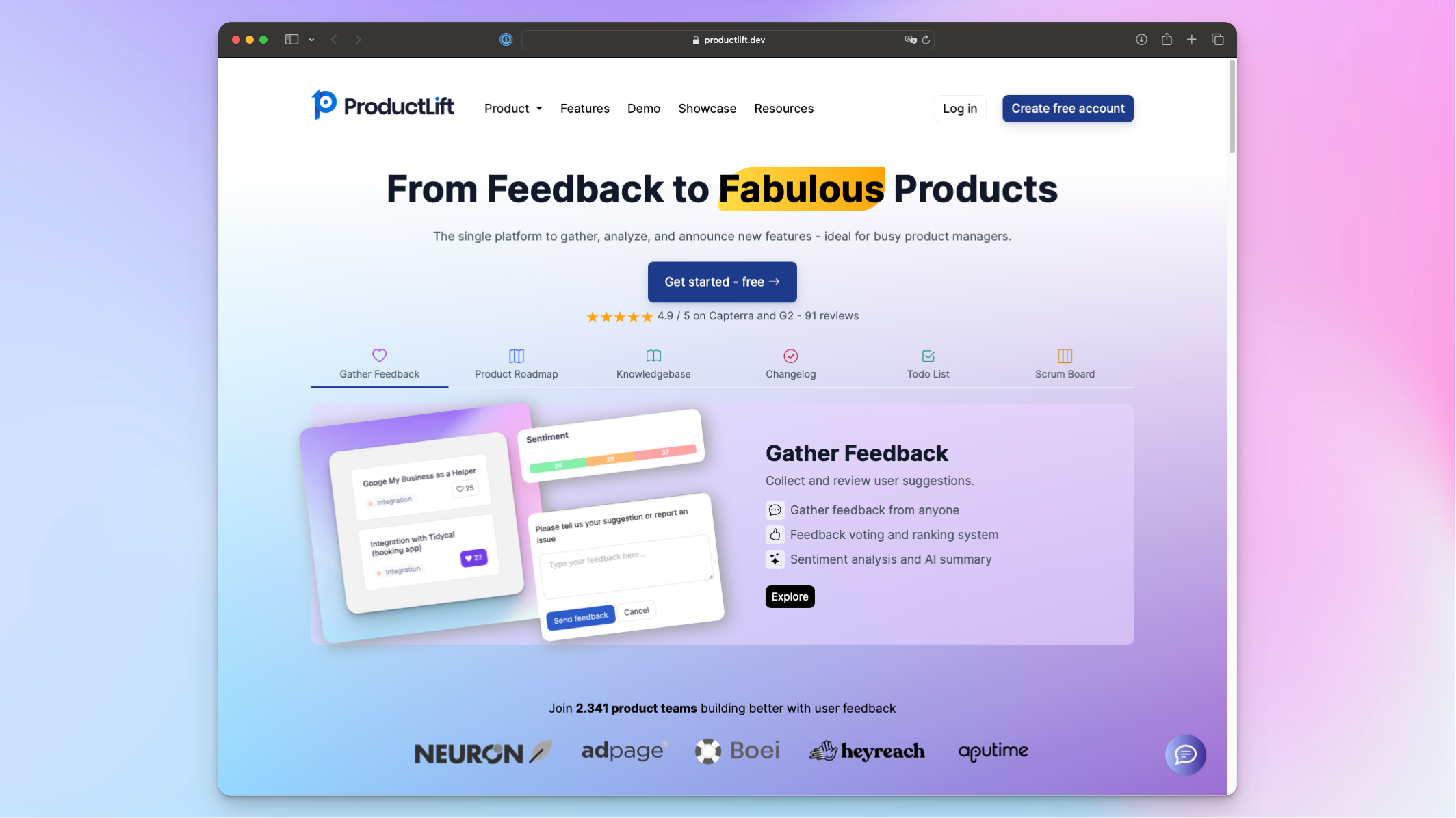
ProductLift is a prioritization, roadmap, and changelog tool for SaaS product managers, project managers, and marketing strategists. Upvote features, define a roadmap, and present product updates.
Read more: 10 ProductLift Alternatives
Features ProductLift has that Aha! doesn’t
- Allows contributions without logging in, enhancing accessibility and engagement.
- Provides weekly reports, ensuring up-to-date insights into user feedback and trends.
- Includes user profiles, personalizing the feedback process and improving user management.
- Includes API access, allowing for extensive customization and integration capabilities.
- Provides estimated dates for feedback implementation, improving transparency and expectations management.
Features ProductLift misses
- No features missing compared to Aha!.
Reviews and Awards Comparison
| Product | G2 | Capterra | Trustpilot |
|---|---|---|---|
| Aha! | 4.3/5 | 4.7/5 | N/A |
| ProductLift | 5.0/5 | 4.9/5 | 4.4/5 |
ProductLift was rewarded G2 - High Performer Small Business - Summer 2023
Language Comparison with Aha!
- ProductLift also supports:
Arabic
Chinese (simplified)
Czech
Finnish
Indonesian
Italian
Polish
Portuguese
Slovenian
Japanese
- Common Languages:
English
Spanish
German
French
Dutch
How much does ProductLift cost?
ProductLift offers a 7 day free trial. Pricing begins at $18.00 per month.
#2 Nolt
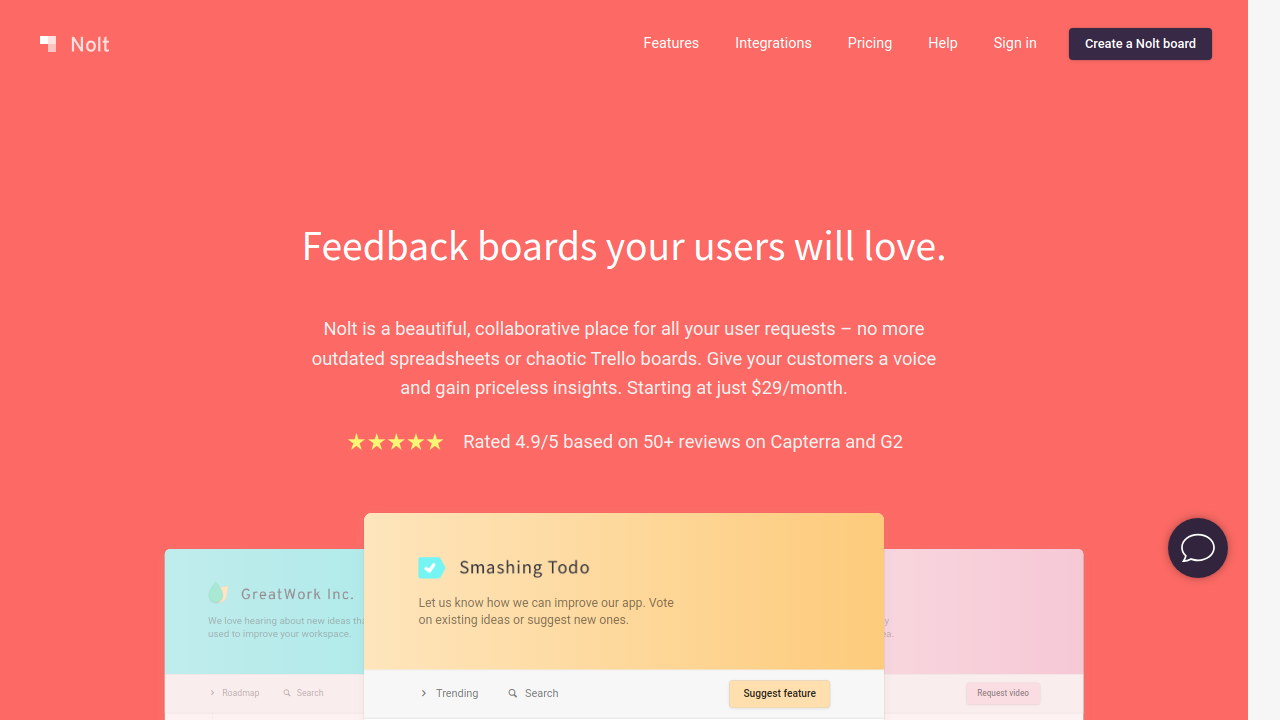
Nolt is a beautiful, collaborative place for all your user requests – no more outdated spreadsheets or chaotic Trello boards. Give your customers a voice and gain priceless insights. Everything for just $25 board/month.
Read more: 6 Nolt Alternatives
Features Nolt has that Aha! doesn’t
- Allows contributions without logging in, enhancing accessibility and engagement.
- Provides weekly reports, ensuring up-to-date insights into user feedback and trends.
- Includes user profiles, personalizing the feedback process and improving user management.
Features Nolt misses
- Lacks a prioritization matrix, making it harder to strategize feedback implementation.
Reviews and Awards Comparison
| Product | G2 | Capterra | Trustpilot |
|---|---|---|---|
| Aha! | 4.3/5 | 4.7/5 | N/A |
| Nolt | 5.0/5 | 4.9/5 | N/A |
Nolt has not received any awards yet.
Language Comparison with Aha!
- Not supported by Nolt:
Spanish
German
French
Dutch
- Common Languages:
English
How much does Nolt cost?
Nolt offers a 10 day free trial. Pricing begins at $29.00 per month.
#3 Frill
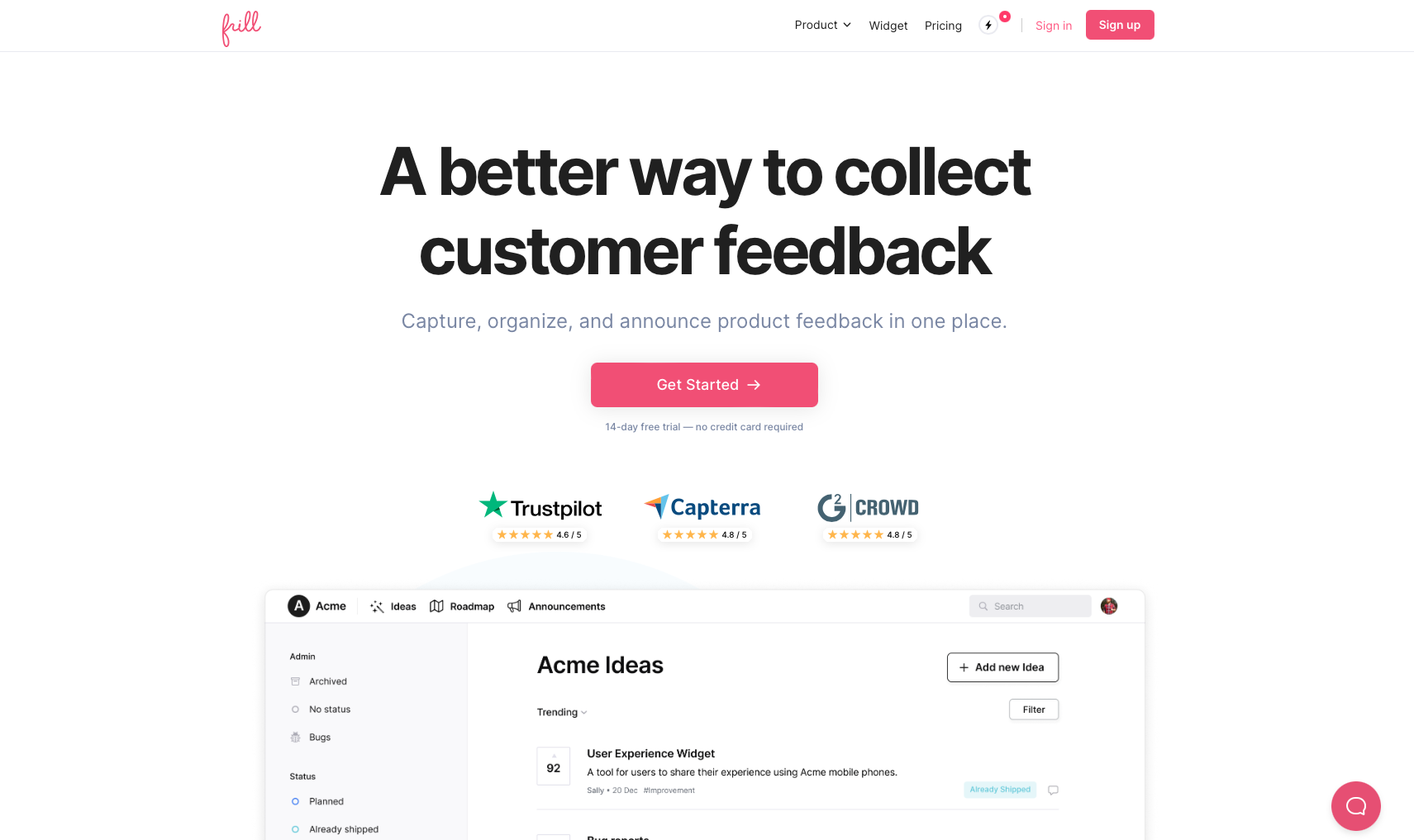
Frill helps you collect and organize feature requests to better understand customer needs and prioritize your roadmap.
Read more: 16 Frill Alternatives
Features Frill has that Aha! doesn’t
- Allows contributions without logging in, enhancing accessibility and engagement.
- Includes API access, allowing for extensive customization and integration capabilities.
Features Frill misses
- No internal comments feature, limiting in-team communication on user feedback.
Reviews and Awards Comparison
| Product | G2 | Capterra | Trustpilot |
|---|---|---|---|
| Aha! | 4.3/5 | 4.7/5 | N/A |
| Frill | 4.8/5 | 4.7/5 | 4.6/5 |
Frill has not received any awards yet.
Language Comparison with Aha!
- Not supported by Frill:
Spanish
German
French
Dutch
- Common Languages:
English
How much does Frill cost?
Frill offers a 14 day free trial. Pricing begins at $25.00 per month.
#4 ProductFlare
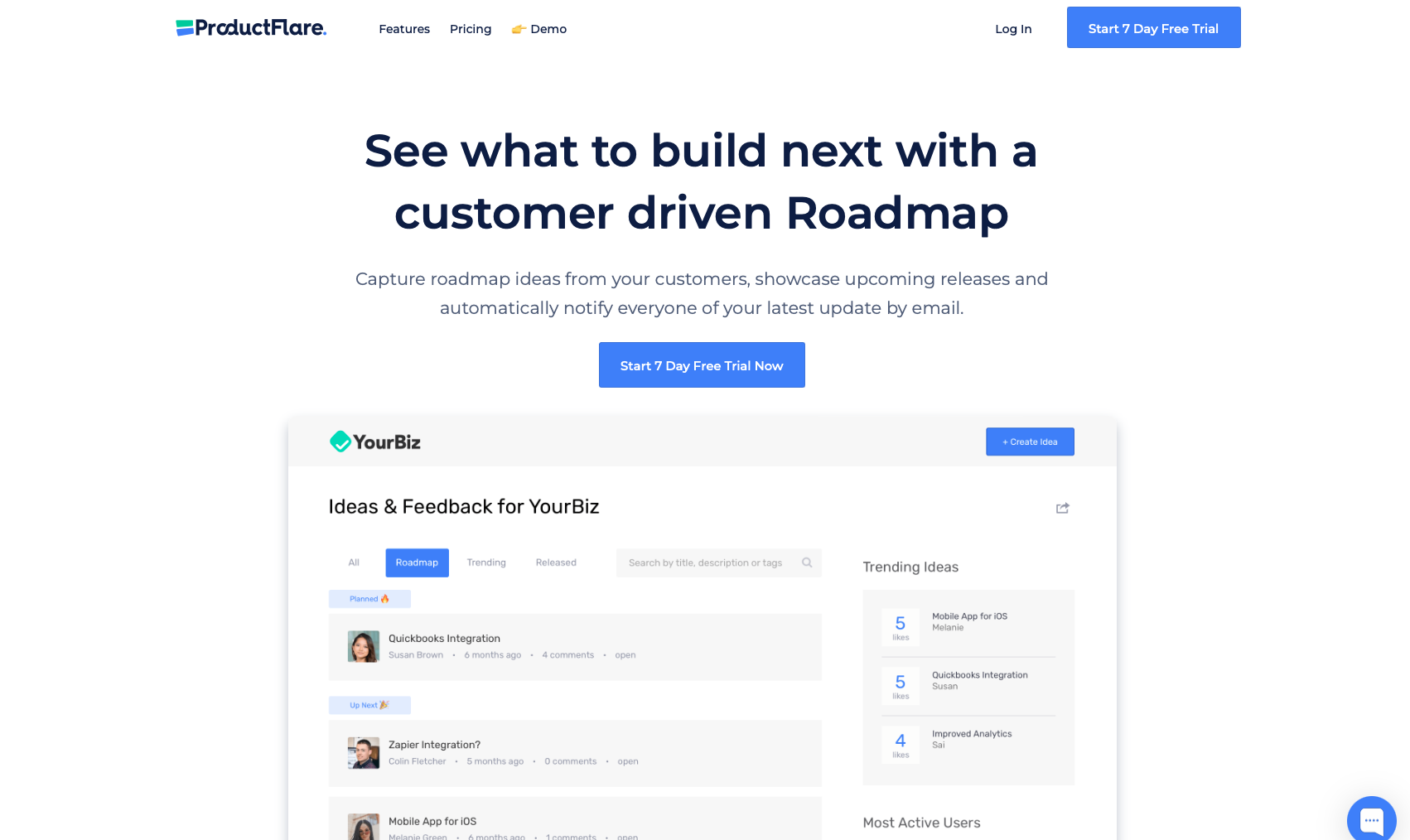
Capture roadmap ideas from your customers, showcase upcoming releases and automatically notify everyone of your latest update by email.
Read more: 5 ProductFlare Alternatives
Features ProductFlare has that Aha! doesn’t
- Includes API access, allowing for extensive customization and integration capabilities.
Features ProductFlare misses
- Lacks private boards, missing out on customizable and controlled feedback environments.
- No internal comments feature, limiting in-team communication on user feedback.
- Lacks a prioritization matrix, making it harder to strategize feedback implementation.
- Lacks Single Sign-On (SSO), missing a layer of convenience and security for users.
- No custom statuses feature, limiting feedback and project tracking customization.
Reviews and Awards Comparison
| Product | G2 | Capterra | Trustpilot |
|---|---|---|---|
| Aha! | 4.3/5 | 4.7/5 | N/A |
| ProductFlare | N/A | 4.5/5 | N/A |
ProductFlare has not received any awards yet.
Language Comparison with Aha!
- Not supported by ProductFlare:
Spanish
German
French
Dutch
- Common Languages:
English
How much does ProductFlare cost?
ProductFlare offers a 7 day free trial. Pricing begins at $49.00 per month.
#5 Pendo
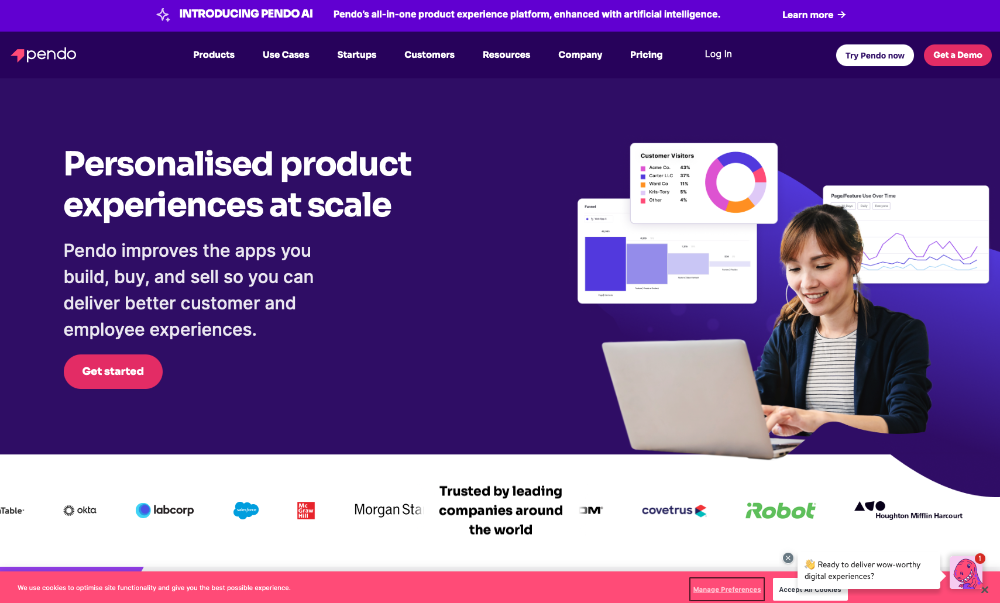
Analytics, in-app guides, and feedback. Together. Everything you need to create the best software experiences for customers and employees.
Read more: 8 Pendo Alternatives
Features Pendo has that Aha! doesn’t
- No additional features compared to Aha!.
Features Pendo misses
- Lacks private boards, missing out on customizable and controlled feedback environments.
- No internal comments feature, limiting in-team communication on user feedback.
- Lacks a prioritization matrix, making it harder to strategize feedback implementation.
- Lacks Single Sign-On (SSO), missing a layer of convenience and security for users.
- No custom statuses feature, limiting feedback and project tracking customization.
Reviews and Awards Comparison
| Product | G2 | Capterra | Trustpilot |
|---|---|---|---|
| Aha! | 4.3/5 | 4.7/5 | N/A |
| Pendo | 4.4/5 | 4.5/5 | 3.2/5 |
Pendo has not received any awards yet.
Language Comparison with Aha!
- Not supported by Pendo:
Spanish
German
French
Dutch
- Common Languages:
English
How much does Pendo cost?
Pendo does not offer a free trial. Pricing begins at $583.00 per month.
#6 Feedbear
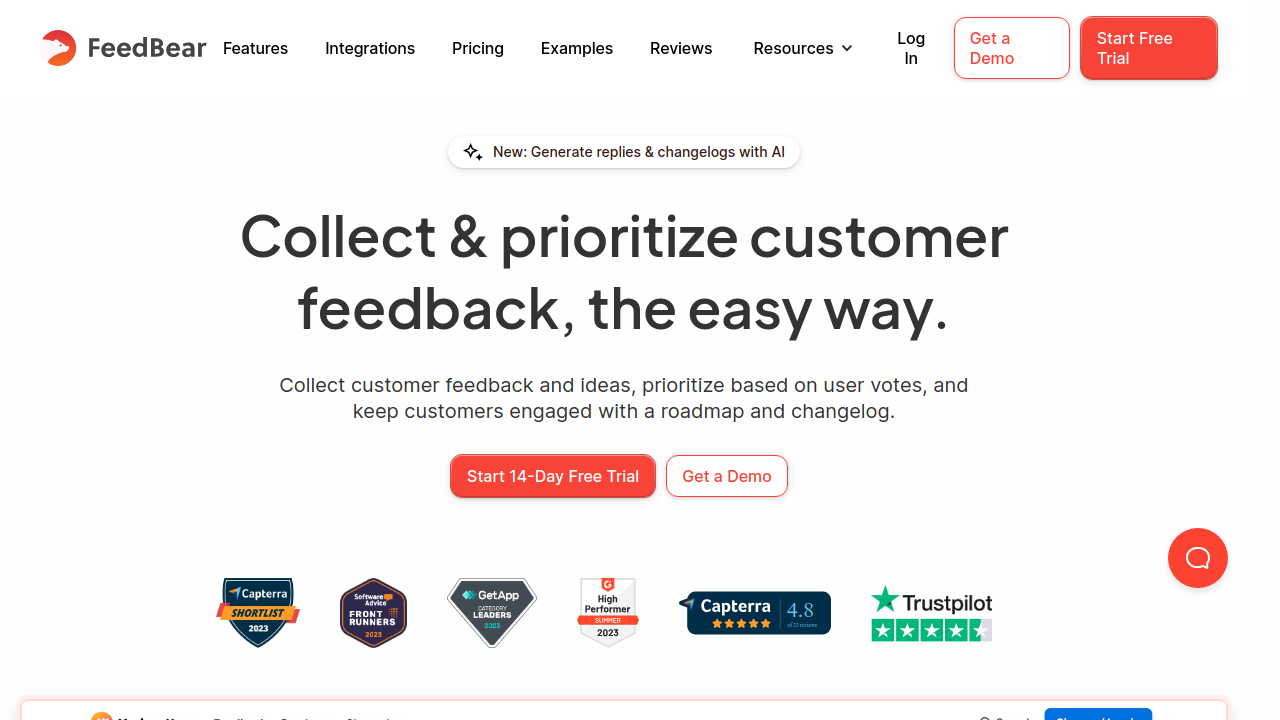
Collect customer feedback and ideas, prioritize based on user votes, and keep customers engaged with a roadmap and changelog.
Read more: 8 Feedbear Alternatives
Features Feedbear has that Aha! doesn’t
- No additional features compared to Aha!.
Features Feedbear misses
- No internal comments feature, limiting in-team communication on user feedback.
- Lacks a prioritization matrix, making it harder to strategize feedback implementation.
Reviews and Awards Comparison
| Product | G2 | Capterra | Trustpilot |
|---|---|---|---|
| Aha! | 4.3/5 | 4.7/5 | N/A |
| Feedbear | 5.0/5 | 4.8/5 | 4.4/5 |
Feedbear was rewarded G2 - High Performer Summer 2023
Language Comparison with Aha!
- Feedbear also supports:
Italian
Portuguese
Chinese (simplified)
- Common Languages:
English
Spanish
German
French
Dutch
How much does Feedbear cost?
Feedbear offers a 14 day free trial. Pricing begins at $49.00 per month.
#7 Canny
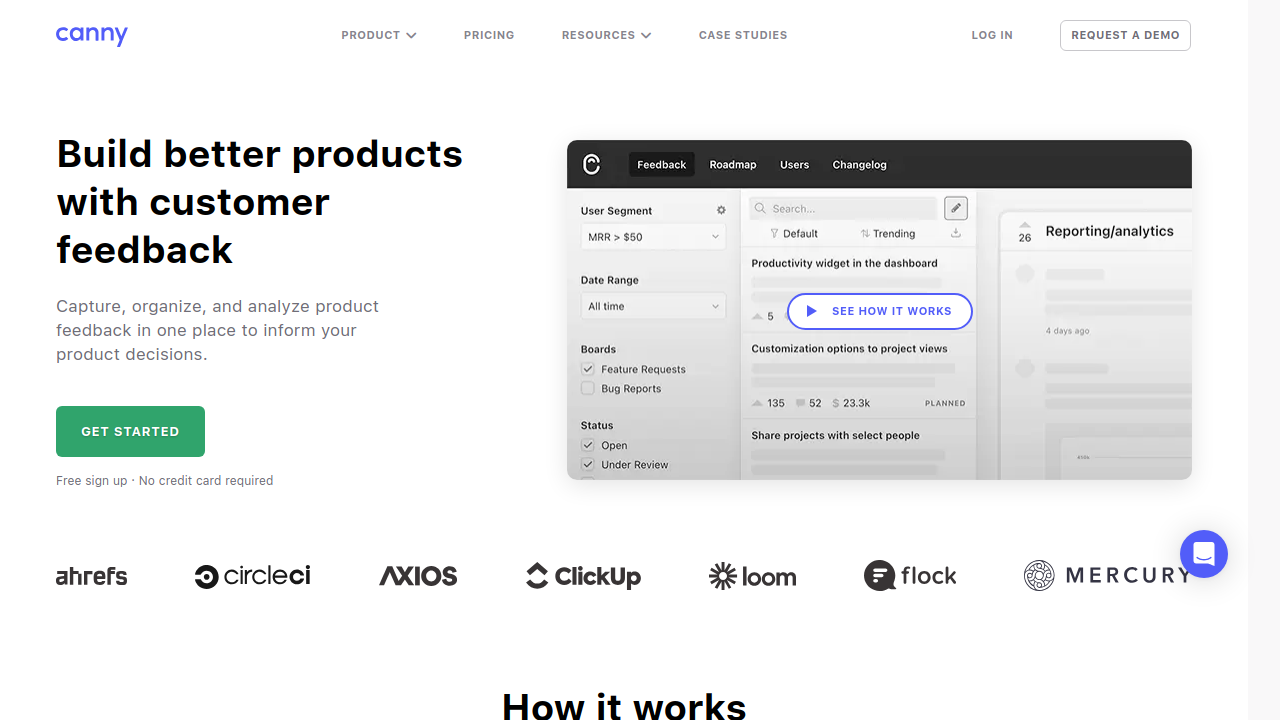
Canny is a single place for all customer feedback. It saves you time managing all the feedback while keeping your customers in the loop. Let your customers post and vote on feedback from within your website or mobile app. You'll get an organized list of feedback that you can use to inform your roadmap.
Read more: 18 Canny Alternatives
Features Canny has that Aha! doesn’t
- Includes API access, allowing for extensive customization and integration capabilities.
- Offers direct integration with Intercom, enhancing customer communication and support.
- Provides estimated dates for feedback implementation, improving transparency and expectations management.
Features Canny misses
- Lacks a prioritization matrix, making it harder to strategize feedback implementation.
- Does not provide a widget for embedding in your product, limiting direct feedback collection capabilities.
Reviews and Awards Comparison
| Product | G2 | Capterra | Trustpilot |
|---|---|---|---|
| Aha! | 4.3/5 | 4.7/5 | N/A |
| Canny | 4.6/5 | 4.7/5 | 3.1/5 |
Canny has not received any awards yet.
Language Comparison with Aha!
- Not supported by Canny:
Spanish
German
French
Dutch
- Common Languages:
English
How much does Canny cost?
Canny does not offer a free trial. Pricing begins at $400.00 per month.
#8 Sleekplan
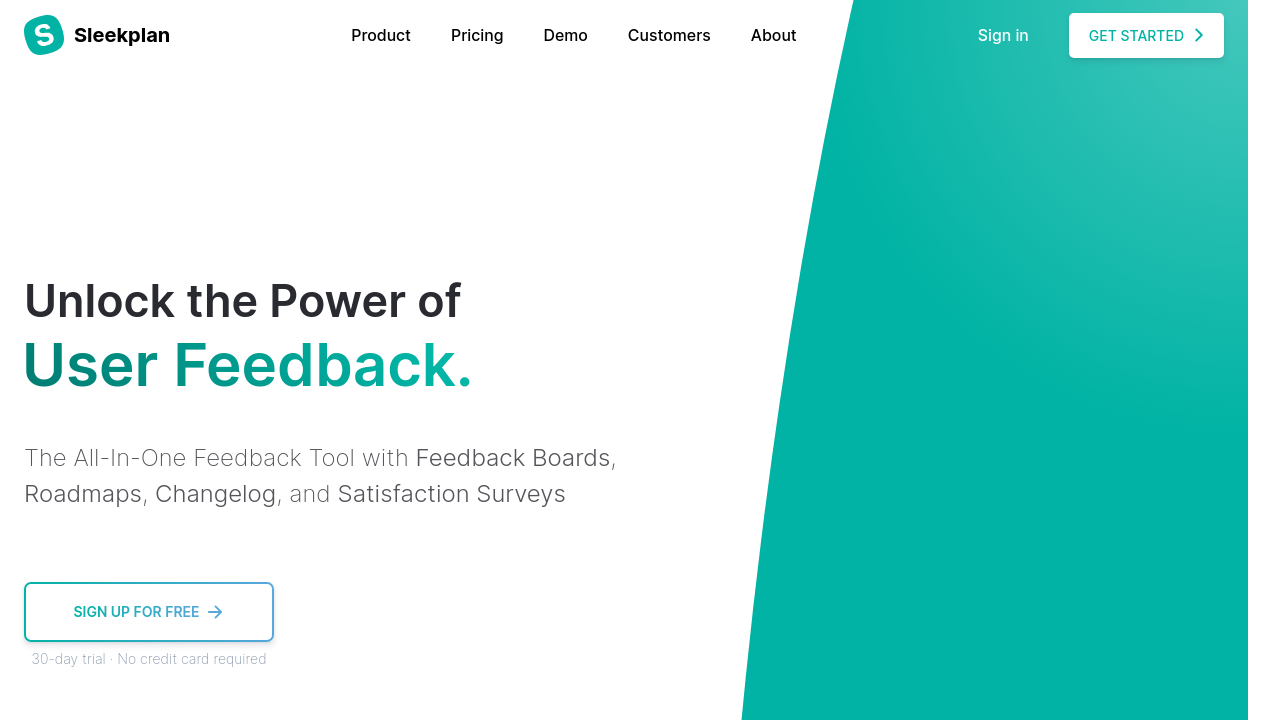
The All-In-One Feedback Tool with Feedback Boards, Roadmaps, Changelog, and Satisfaction Surveys
Read more: 11 Sleekplan Alternatives
Features Sleekplan has that Aha! doesn’t
- Provides weekly reports, ensuring up-to-date insights into user feedback and trends.
- Includes user profiles, personalizing the feedback process and improving user management.
- Includes API access, allowing for extensive customization and integration capabilities.
Features Sleekplan misses
- Lacks private boards, missing out on customizable and controlled feedback environments.
- Lacks a prioritization matrix, making it harder to strategize feedback implementation.
- No custom statuses feature, limiting feedback and project tracking customization.
Reviews and Awards Comparison
| Product | G2 | Capterra | Trustpilot |
|---|---|---|---|
| Aha! | 4.3/5 | 4.7/5 | N/A |
| Sleekplan | 4.8/5 | 5.0/5 | 4/5 |
Sleekplan has not received any awards yet.
Language Comparison with Aha!
- Not supported by Sleekplan:
Spanish
German
French
Dutch
- Common Languages:
English
How much does Sleekplan cost?
Sleekplan offers a 30 day free trial. Pricing begins at $15.00 per month.
#9 Headway
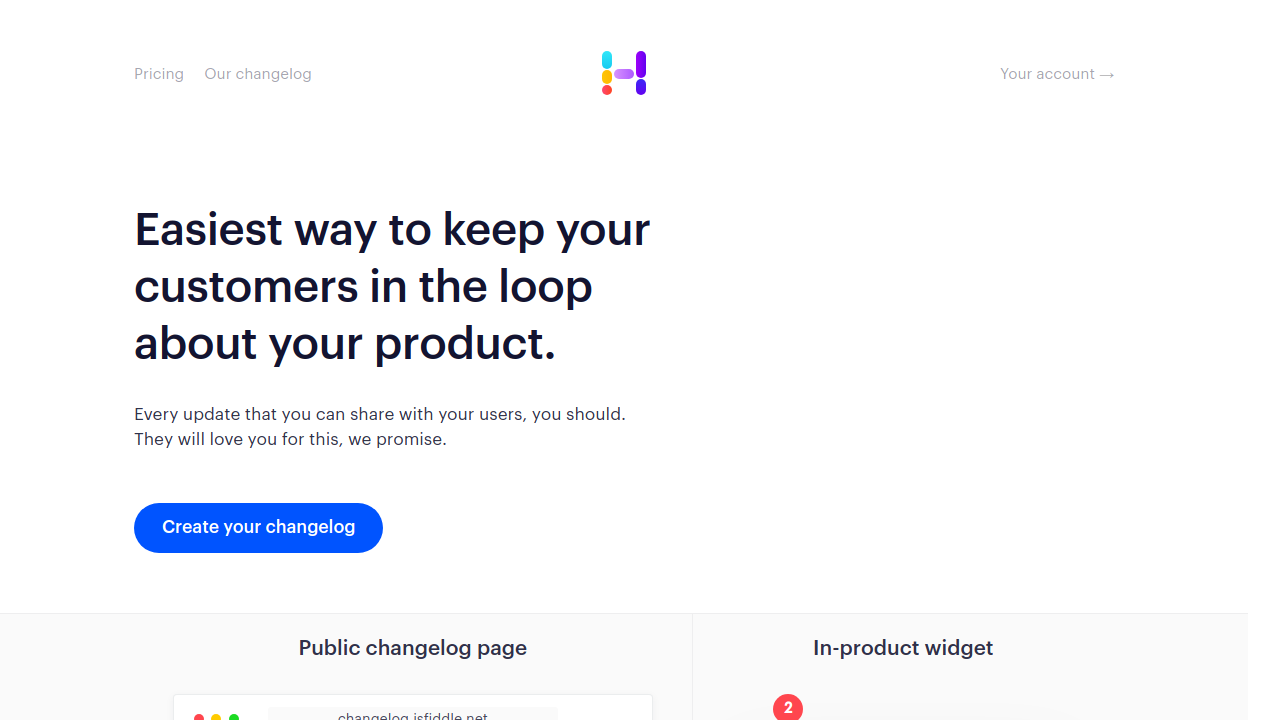
Changelog software to keep your customers in the loop about your product.
Read more: 10 Headway Alternatives
Features Headway has that Aha! doesn’t
- No additional features compared to Aha!.
Features Headway misses
- Lacks private boards, missing out on customizable and controlled feedback environments.
- No internal comments feature, limiting in-team communication on user feedback.
- Lacks a prioritization matrix, making it harder to strategize feedback implementation.
- Lacks Single Sign-On (SSO), missing a layer of convenience and security for users.
- No custom statuses feature, limiting feedback and project tracking customization.
Reviews and Awards Comparison
| Product | G2 | Capterra | Trustpilot |
|---|---|---|---|
| Aha! | 4.3/5 | 4.7/5 | N/A |
| Headway | 3.0/5 | 5.0/5 | N/A |
Headway has not received any awards yet.
Language Comparison with Aha!
- Not supported by Headway:
Spanish
German
French
Dutch
- Common Languages:
English
How much does Headway cost?
Headway does not offer a free trial. Pricing begins at $29.00 per month.
#10 Noora
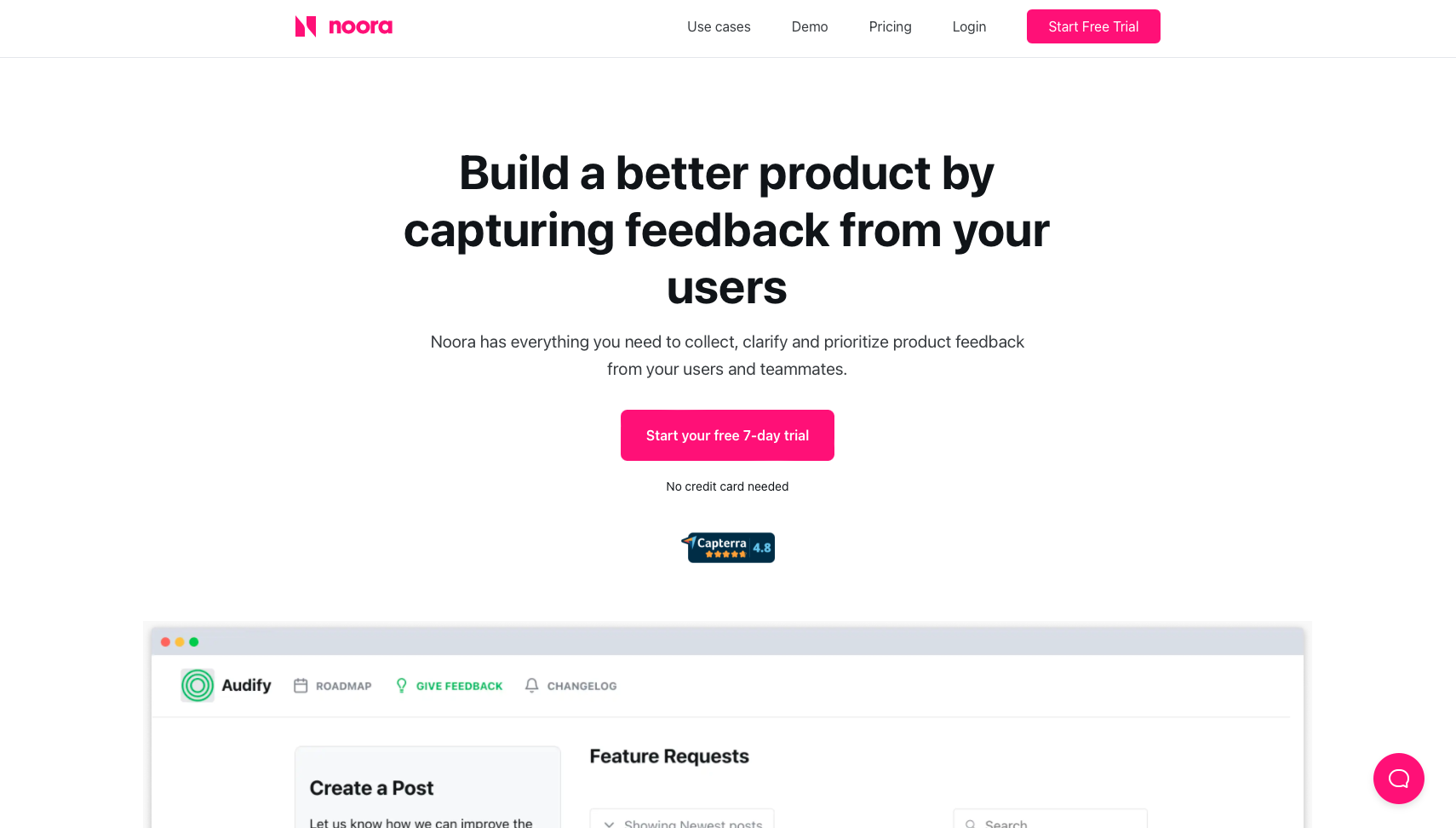
Noora has everything you need to collect, clarify and prioritize product feedback from your users and teammates.
Read more: 11 Noora Alternatives
Features Noora has that Aha! doesn’t
- Allows contributions without logging in, enhancing accessibility and engagement.
- Includes API access, allowing for extensive customization and integration capabilities.
Features Noora misses
- Lacks a prioritization matrix, making it harder to strategize feedback implementation.
- No custom statuses feature, limiting feedback and project tracking customization.
Reviews and Awards Comparison
| Product | G2 | Capterra | Trustpilot |
|---|---|---|---|
| Aha! | 4.3/5 | 4.7/5 | N/A |
| Noora | N/A | 4.8/5 | N/A |
Noora has not received any awards yet.
Language Comparison with Aha!
- Not supported by Noora:
Spanish
German
French
Dutch
- Common Languages:
English
How much does Noora cost?
Noora offers a 7 day free trial. Pricing begins at $29.00 per month.
#11 FeatureUpvote
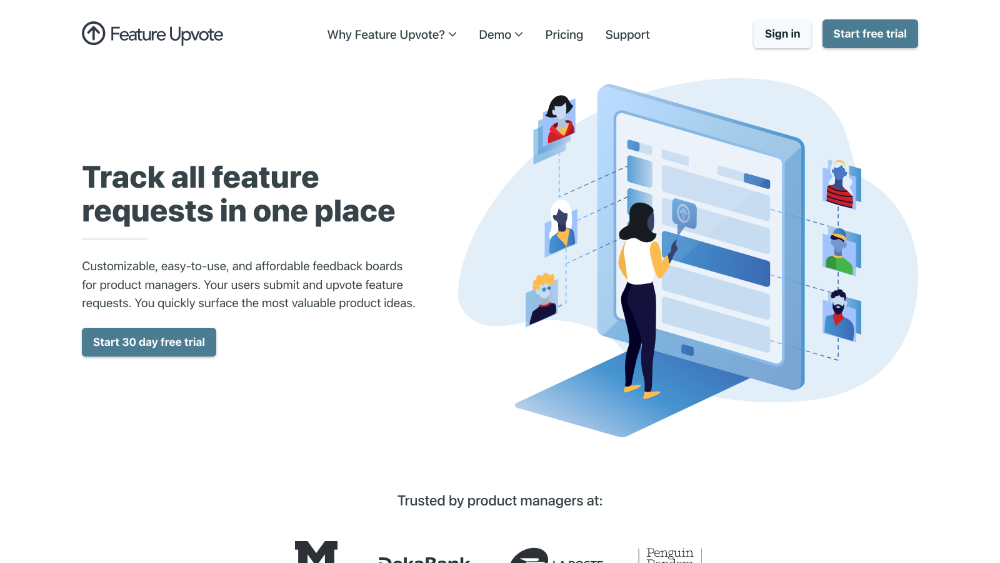
Customizable, easy-to-use, and affordable feedback boards for product managers. Your users submit and upvote feature requests. You quickly surface the most valuable product ideas.
Read more: 11 FeatureUpvote Alternatives
Features FeatureUpvote has that Aha! doesn’t
- No additional features compared to Aha!.
Features FeatureUpvote misses
- Lacks private boards, missing out on customizable and controlled feedback environments.
- No internal comments feature, limiting in-team communication on user feedback.
- Lacks a prioritization matrix, making it harder to strategize feedback implementation.
- Lacks Single Sign-On (SSO), missing a layer of convenience and security for users.
- No custom statuses feature, limiting feedback and project tracking customization.
Reviews and Awards Comparison
| Product | G2 | Capterra | Trustpilot |
|---|---|---|---|
| Aha! | 4.3/5 | 4.7/5 | N/A |
| FeatureUpvote | N/A | N/A | N/A |
FeatureUpvote has not received any awards yet.
Language Comparison with Aha!
- Not supported by FeatureUpvote:
Spanish
German
French
Dutch
- Common Languages:
English
How much does FeatureUpvote cost?
FeatureUpvote offers a 30 day free trial. Pricing begins at $57.00 per month.
#12 Hellonext
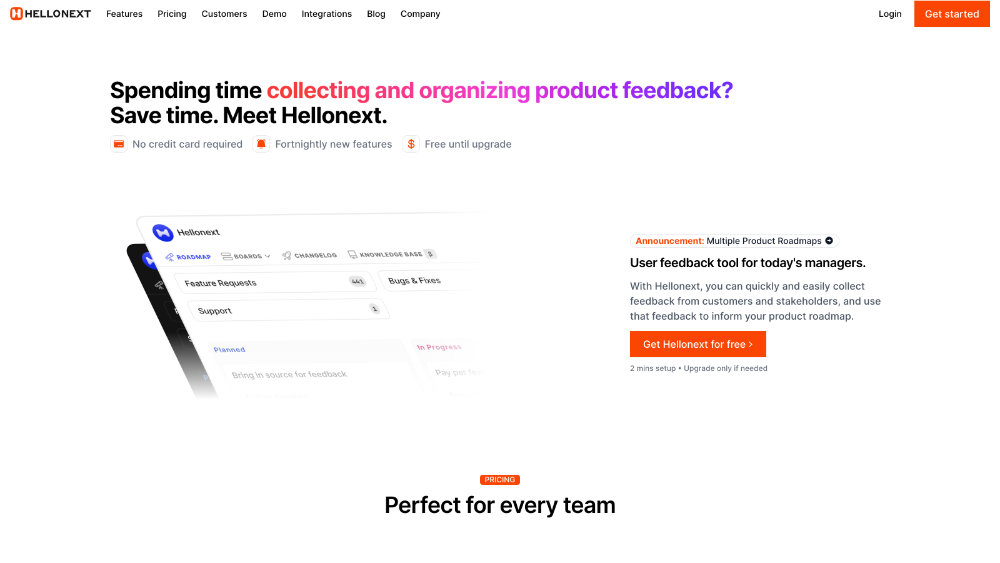
Hellonext lets you centralize, organize, and respond to customer feedback in one place. Your users can also upvote on existing feedback from other users
Read more: 11 Hellonext Alternatives
Features Hellonext has that Aha! doesn’t
- Includes API access, allowing for extensive customization and integration capabilities.
- Offers direct integration with Intercom, enhancing customer communication and support.
- Provides estimated dates for feedback implementation, improving transparency and expectations management.
Features Hellonext misses
- Lacks a prioritization matrix, making it harder to strategize feedback implementation.
Reviews and Awards Comparison
| Product | G2 | Capterra | Trustpilot |
|---|---|---|---|
| Aha! | 4.3/5 | 4.7/5 | N/A |
| Hellonext | 5.0/5 | N/A | N/A |
Hellonext has not received any awards yet.
Language Comparison with Aha!
- Not supported by Hellonext:
Spanish
German
French
Dutch
- Common Languages:
English
How much does Hellonext cost?
Hellonext does not offer a free trial. Pricing begins at $65.00 per month.
#13 Rapidr
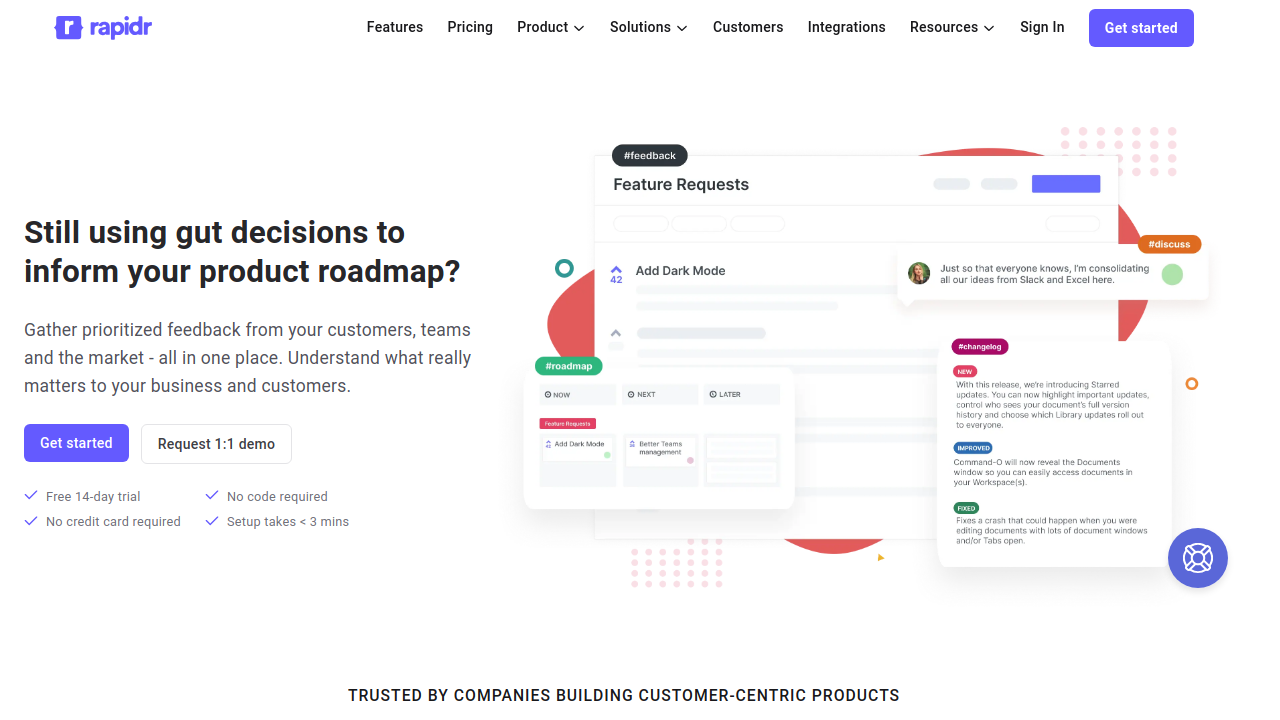
Rapidr is everything we need to prioritize our product roadmap based on feedback from users.
Read more: 12 Rapidr Alternatives
Features Rapidr has that Aha! doesn’t
- No additional features compared to Aha!.
Features Rapidr misses
- Lacks a prioritization matrix, making it harder to strategize feedback implementation.
Reviews and Awards Comparison
| Product | G2 | Capterra | Trustpilot |
|---|---|---|---|
| Aha! | 4.3/5 | 4.7/5 | N/A |
| Rapidr | 4.5/5 | N/A | N/A |
Rapidr has not received any awards yet.
Language Comparison with Aha!
- Not supported by Rapidr:
Spanish
German
French
Dutch
- Common Languages:
English
How much does Rapidr cost?
Rapidr offers a 14 day free trial. Pricing begins at $49.00 per month.
#14 UserVoice
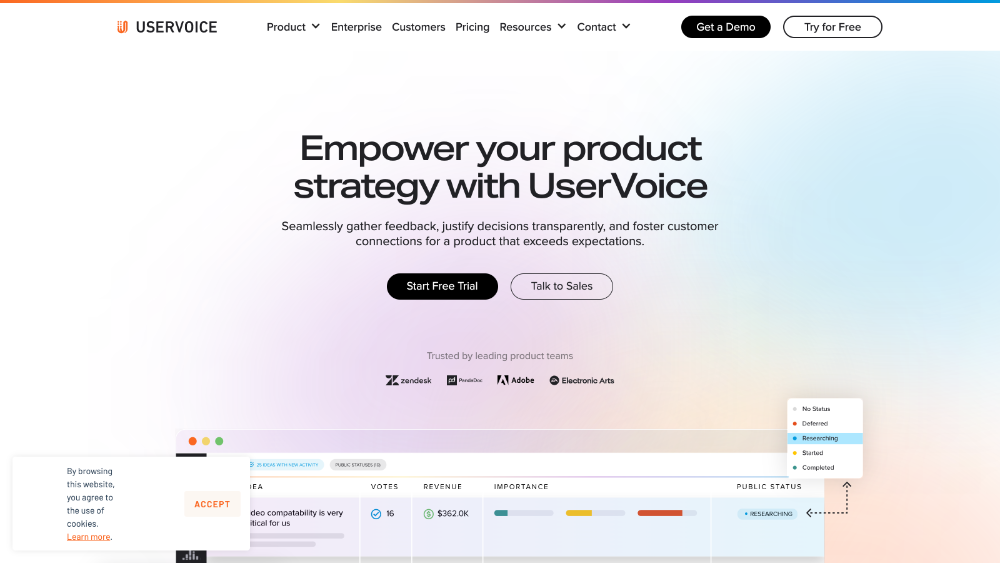
The ultimate tool for product discovery. Transform your product’s future through real user feedback, guiding you to uncover problems worth solving and solutions worth building. Join us and start your discovery journey today.
Read more: 15 UserVoice Alternatives
Features UserVoice has that Aha! doesn’t
- Includes API access, allowing for extensive customization and integration capabilities.
Features UserVoice misses
- Lacks private boards, missing out on customizable and controlled feedback environments.
- No custom statuses feature, limiting feedback and project tracking customization.
Reviews and Awards Comparison
| Product | G2 | Capterra | Trustpilot |
|---|---|---|---|
| Aha! | 4.3/5 | 4.7/5 | N/A |
| UserVoice | 4.5/5 | 4.2/5 | 2.8/5 |
UserVoice has not received any awards yet.
Language Comparison with Aha!
- Not supported by UserVoice:
Spanish
German
French
Dutch
- Common Languages:
English
How much does UserVoice cost?
UserVoice offers a 21 day free trial. Pricing begins at $699.00 per month.
The best alternative for Aha!
If you're on the hunt for a top Aha! alternative, look no further than ProductLift. This advanced feedback management tool provides an efficient platform for gathering and organizing feedback and managing product changes, a process crucial to all product teams.
ProductLift, unlike Aha!, offers more than just the basic features. This tool allows you to establish a streamlined feedback loop, transforming raw product feedback into actionable tasks and feature requests. Its unique selling point is its ability to help you better understand customer needs and prioritize accordingly.
ProductLift extends its capabilities beyond a simple changelog tool. It comes equipped with a notification widget that can announce your latest product updates. You can also leverage its email notifications system to keep users up-to-date with the latest updates. Its advanced usage capabilities offer more than just collecting feedback. It helps you understand and align with your customers’ needs.
One of ProductLift's best features is its ability to handle customer feedback management. It's designed to cover the whole feedback loop from collecting customer feedback to implementing changes based on that feedback. This makes ProductLift a comprehensive feedback management system that enables you to build better products.
Unlike Aha!, ProductLift also offers a custom domain option, enabling you to maintain brand consistency. Its affordable alternative pricing structure, including a free plan and free trial, makes it an attractive switch from Aha! for many SaaS companies.
As a comprehensive feedback tool, ProductLift enables you to manage customer feedback efficiently and turn it into actionable insights. ProductLift's unique ability to help you better understand customer needs and prioritize product features sets it apart from other alternatives. Ultimately, ProductLift enables you to build better products, enhance your product offerings, and keep your customers satisfied and engaged.
